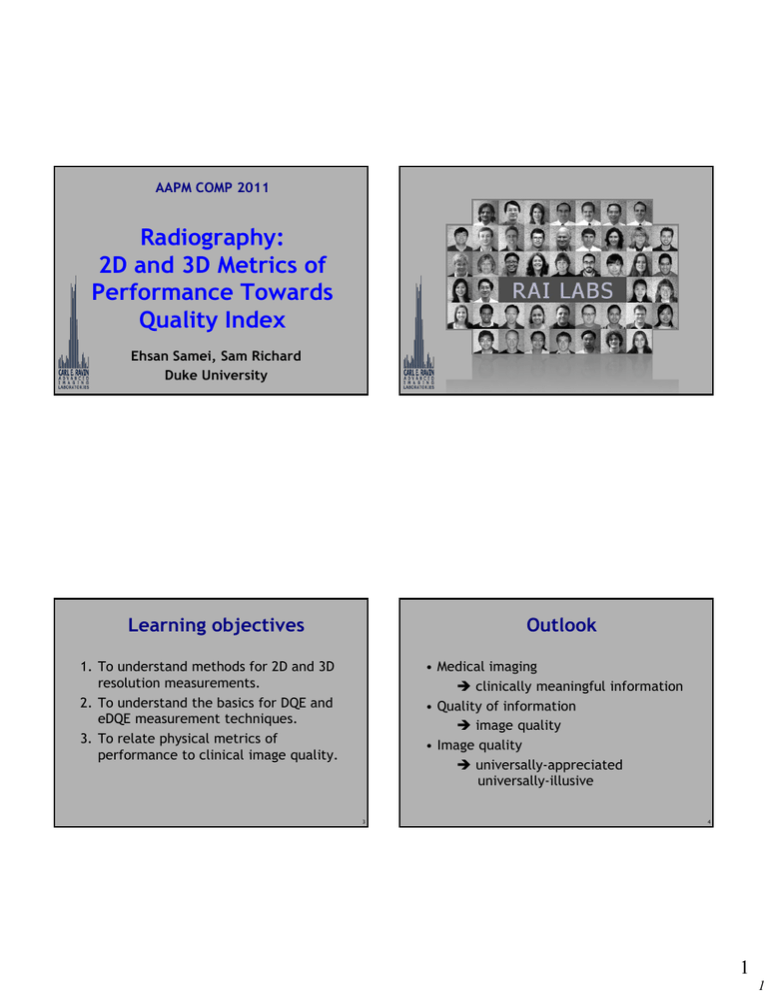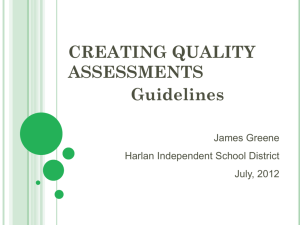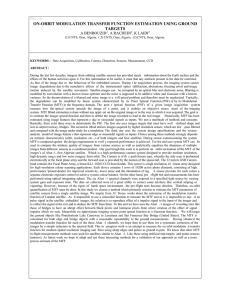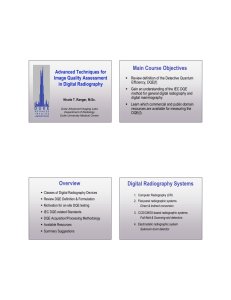Radiography: 2D and 3D Metrics of Performance Towards Quality Index
advertisement

AAPM COMP 2011
Radiography:
2D and 3D Metrics of
Performance Towards
Quality Index
Ehsan Samei, Sam Richard
Duke University
Learning objectives
Outlook
1. To understand methods for 2D and 3D
resolution measurements.
2. To understand the basics for DQE and
eDQE measurement techniques.
3. To relate physical metrics of
performance to clinical image quality.
• Medical imaging
clinically meaningful information
• Quality of information
image quality
• Image quality
universally-appreciated
universally-illusive
3
4
1
1
Physical metrics of image
quality
What is image quality?
• Image esthetics
• Convenient and practical
• Effective to the extent they can be
related to diagnostic performance
• Applicable under qualified conditions:
– Subjective and qualitative
– Not necessarily reflective of diagnostic
performance
• Diagnostic accuracy
–
–
–
–
–
– Expensive
– Impractical given the extent and
variability of technologies
Resolution
Detector vs system
Incorporation of scattered radiation
Incorporation of anatomical attributes
Incorporation of task attributes
System-based vs image-based metrics
Resolution
• Ability to resolve distinct features of an
image from each other
• Best characterized by the modulation
transfer function (MTF):
– The efficiency of an imaging system
in reproducing subject contrast at
various spatial frequencies
MTF = F{LSF(x)}
Low resolution
High resolution
7
8
2
2
High MTF
Low MTF
9
10
Noise
Noise
• Unwanted signals that interfere with
interpretation
• Best characterized by the noise power
spectrum (NPS):
– The variance of noise in an image in
terms of the spatial frequencies
ACF ( x )
1
L
i ( x x ' )i ( x ' )dx '
L
NPS( f ) { ACF ( x )}
Low resolution
High resolution
High res/ high noise
11
12
3
3
Image without noise
Uncorrelated noise
13
Correlated noise
14
Noise and Resolution =>
SNR
• Threshold contrast and diameter ~
1/SNR (Rose model)
• Higher the SNR =>
Features w/ smaller C and D can be detected
2
NEQ( f ) = SNR
2
actual
15
=
MTF( f )
NNPS( f )
16
4
4
Measurement method
SNR efficiency
• Best characterized by the detective
quantum efficiency (DQE):
– Efficiency of a detector to utilize
the maximum possible SNR provided
by the finite number of x-ray
photons forming the image
2
DQE( f ) =
SNRactual
2
SNRideal
• Beam quality and magnitude
– kVp
– Filtration
– Exposure
• Access to linear or linearized data
2
=
MTF( f )
NNPS( f ) × E0 × q
17
Al purity
Aluminum versus Copper
• IEC recommendation: >99.9% purity
RQA5, 99.0% purity
18
RQA5, 70 kVp
21 mm Al 99.0% purity
RQA5’, 70 kVp
0.5 mm Cu, 1 mm Al
RQA5, 99.99% purity
Ranger et al, Med Phys, July 2005
19
Murphy et al, AAPM/COMP 2011
20
5
5
MTF methodology: Edge
Edge image processing
• Edge test device
• ESF deduced from image data
• MTF from ESF via differentiation
and Fourier trans.
• High precision, particularly at
low frequencies
• Simple and quick alignment
• Established method (endorsed
by the IEC)
1. Finding the edge angle
–
–
Least square fits
Differentiation and Hough or Radon transform
21
22
railabs.org/resources
Edge image processing
2. 2D projection to obtain
ESF
3. ESF differentiation and
smoothing to obtain LSF
4. Fourier transformation
of LSF to get the
presampled MTF
5. Normalization of the
MTF at 0 frequency
6. Rebinning the MTF
(0.05 mm-1 per IEC)
23
24
6
6
Effect of
method
(GE XQ/i)
Diffs
<6%
overall
<8%
single f
Effect of
method
(ideal)
Slit
Slit
Diffs
<0.3% for
slit
Trans edge
Opaque edge
True MTF
Edge
<5.2% for
edge
25
Effect of
method
(w/ glare)
26
DQE methodology
Edge
Slit
2
Diffs
<10% for
slit
DQE( f ) =
True MTF
<2% for
edge
27
SNRactual
2
SNRideal
2
=
MTF( f )
NNPS( f ) × E0 × q
MTF
=>
Measured
NNPS
=>
Measured
E0
=>
Measured
q (SNR2ideal/E0) =>
Estimated
28
7
7
Adding
magnification, scatter, grid
DQE
Detector
Grid
Tube
Patient
29
eDQE
Adding
magnification, scatter, grid
2
DQE( f ) =
SNRactual
2
SNRideal
eDQE( fm )=
30
Ped CXR
Adult CXR
XL Adult CXR
2
=
MTF( f )
NNPS( f ) × E0 × q
eMTF( fm )2 × (1- SF )
2
eNNPS( fm )×TFnb × E0 × q
Samei et al, Med Phys, 2009
31
32
8
8
From DQE to IQ
Resolution and
contrast transfer
×
Attributes of image
feature of interest
Image noise:
magnitude and texture
Model observers
Fisher-Hotelling observer (FH)
(d )
2
'
FH
=
òò
2
MTF 2 (u,v)WTask
(u,v)
dudv
NPS(u,v)
Non-prewhitening observer (NPW)
(d )
'
NPW
2
=
[ òò MTF
òò MTF
2
2
2
(u,v)WTask
(u,v)dudv
]
0.2
0.18
2
0.16
0.14
0.12
0.1
2
(u,v)WTask
(u,v)NPS(u,v)dudv
0.08
0.06
Eye filter
0.04
d ' = ò eDQE( fm ).W( f ) fdf
2
2
Validation of model
observers
Richard, Li, Samei, SPIE 2011
0.02
NPW observer with eye filter (NPWE)
[ òò MTF (u,v)W (u,v)E (u,v)dudv ]
(d ) = MTF (u,v)W (u,v)NPS(u,v)E (u,v) + MTF (u,v)W
òò
0
2
2
'
NPWE
2
2
Task
2
Task
0.1
0.2
0.3
0.4
0.5
0.6
0.7
0.8
0.9
1
2
2
4
0
2
2
Task
(u,v)N i dudv
eDQE applied to acquisition
optimization
Boyce et al, Med Phys, 2005
36
9
9
From DQE to IQ and dose:
Effective Dose Efficiency (eDE)
Summary
ES æ SSD ö
´ç
÷
ED è SID ø
2
eDE( fm ) = eDQE( fm ) ´ q ´
Samei et al, PMB, 2011
medicalphysicsweb.org, July 29, 2011
• MTF can be robustly measured using
edge method
• DQE provides a meaningful measure of
detector performance correlated with
human performance
• DQE can be readily extended to system
performance (via eDQE)
• DQE can readily be normalized by dose
(eDE) for acquisition optimization
37
38
10
10




